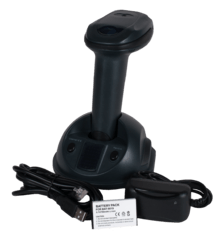Inventory control
Inventory control or stock control can be broadly defined as "the activity of checking a shop’s stock."[1] However, a more focused definition takes into account the more science-based, methodical practice of not only verifying a business' inventory but also focusing on the many related facets of inventory management (such as forecasting future demand) "within an organisation to meet the demand placed upon that business economically."[2] Other facets of inventory control include supply chain management, production control, financial flexibility, and customer satisfaction.[3]
An extension of inventory control is the inventory control system. This may come in the form of a technological system and its programmed software used for managing various aspects of inventory problems[4] , or it may refer to a methodology (which may include the use of technological barriers) for handling loss prevention in a business.[5][6]
Inventory control systems

An inventory control system is used to keep inventories in a desired state while continuing to adequately supply customers[7][8], and its success depends on maintaining clear records on a periodic or perpetual basis.[8][9]
Inventory management software often plays an important role in the modern inventory control system, providing timely and accurate analytical, optimization, and forecasting techniques for complex inventory management problems.[10][11] Typical features of this type of software include[8][11]:
- inventory tracking and forecasting tools that use selectable algorithms and review cycles to identify anomalies and other areas of concern
- inventory optimization
- purchase and replenishment tools that include automated and manual replenishment components, inventory calculations, and lot size optimization
- lead time variability management
- safety stock calculation and forecasting
- inventory cost management
- shelf-life and slow-mover logic
- multiple location support
- Mobile/Moving Inventory Support
Through this functionality, a business may better detail what has sold, how quickly, and at what price, for example. Reports could be used to predict when to stock up on extra products around a holiday or to make decisions about special offers, discontinuing products, and so on.
Inventory control techniques often rely upon barcodes and radio-frequency identification (RFID) tags to provide automatic identification of inventory objects—including but not limited to merchandise, consumables, fixed assets, circulating tools, library books, and capital equipment—which in turn can be processed with inventory management software.[12] A new trend in inventory management is to label inventory and assets with a QR Code, which can then be read with smart-phones to keep track of inventory count and movement.[13] These new systems are especially useful for field service operations, where an employee needs to record inventory transaction or look up inventory stock in the field, away from the computers and hand-held scanners.
Advantages and disadvantages
Inventory control systems have advantages and disadvantages, based on what style of system is being run. A purely periodic (physical) inventory control system takes "an actual physical count and valuation of all inventory on hand ... at the close of an accounting period,"[14] whereas a perpetual inventory control system takes an initial count of an entire inventory and then closely monitors any additions and deletions as they occur.[14][9] Various advantages and disadvantages, in comparison, include:
- Periodic is technically the more accurate as it considers both counted and valued inventory.[14]
- Periodic is more time-consuming than perpetual.[14]
- Perpetual can lower the cost of carrying inventory vs. periodic.[9]
- Perpetual is typically more costly to run than periodic.[9]
- Perpetual needs to be verified from time to time against an actual physical count, due to scrap, human error, theft, and other variables.[14][15]
Inventory Control vs. Inventory Management
While it is sometimes used interchangeably, inventory management and inventory control deal with different aspects of inventory.
Inventory management involves tracking inventory throughout the supply chain, from sourcing to order fulfilment. Inventory control is the process of managing stock once it arrives at a warehouse, store or other storage location. It involves planning for sales and stock-outs, optimizing inventory for maximum benefit and preventing the pile-up of dead stock.[16]
See also
|
|
References
- "stock control". Macmillan Dictionary. Macmillan Publishers Limited. Retrieved 21 June 2018.
- Lewis, C. (2012). "Chapter 1: Demand forecasting and inventory control". Demand Forecasting and Inventory Control. Routledge. p. 3–20. ISBN 9781136346835.
- Axsäter, S. (2015). "Chapter 1: Introduction". Inventory Control. Springer. p. 1–6. ISBN 9783319157290.
- Axsäter, S. (2015). "Chapter 2: Forecasting". Inventory Control. Springer. p. 7–35. ISBN 9783319157290.
- Hayes, R. (2014). Retail Security and Loss Prevention. Butterworth-Heinemann. p. 30. ISBN 9781483296005.
- Wesley, R.L.; Wanat, J.A. (2016). A Guide to Internal Loss Prevention. Elsevier. pp. 81–3. ISBN 9781483135731.
- Chorafas, D.N. (ed.). "Chapter 13: Specifications for Inventory Control". Systems and Simulation. Elsevier. pp. 233–52. doi:10.1016/S0076-5392(09)60019-9. ISBN 9780123749185.
- Axsäter, S. (2015). "Chapter 11: Implementation". Inventory Control. Springer. p. 223–34. ISBN 9783319157290.
- Wild, R. (2002). Essentials of Operations Management. Cengage Learning. pp. 332–3. ISBN 9781844800520.
- Azadivar, F.; Rangarajan, A. (2016). "10.6 Inventory Management in Practice". In Ravindran, A.R. (ed.). Operations Research and Management Science Handbook. CRC Press. pp. 10-34–10-35. ISBN 9781420009712.
- Donath, B.; Mazel, J.; Dubin, C.; Patterson, P., eds. (2002). "Part II Inventory Management - Chapter 4: Software and Technology". The IOMA Handbook of Logistics and Inventory Management. John Wiley & Sons. pp. 504–38. ISBN 9780471209355.
- Gulati, R.; Smith, R. (2009). Maintenance and Reliability Best Practices. Industrial Press, Inc. pp. 122–4. ISBN 9780831133115.
- Pantano, E.; Nguyen, B.; Dennis, C.; et al. (2017). Internet Retailing and Future Perspectives. Routledge. p. PT301. ISBN 9781317378761.
- Dopson, L.R.; Hayes, D.K. (2015). Food and Beverage Cost Control. John Wiley & Sons. pp. 115–17. ISBN 9781118988497.
- Waller, M.A.; Esper, T.L. (2014). The Definitive Guide to Inventory Management: Principles and Strategies for the Efficient Flow of Inventory Across the Supply Chain. Pearson Education. pp. 150–1. ISBN 9780133448825.
- "What Is Inventory Control? Importance of an Inventory Control System?". Primaseller. 2019-05-03. Retrieved 2020-02-18.